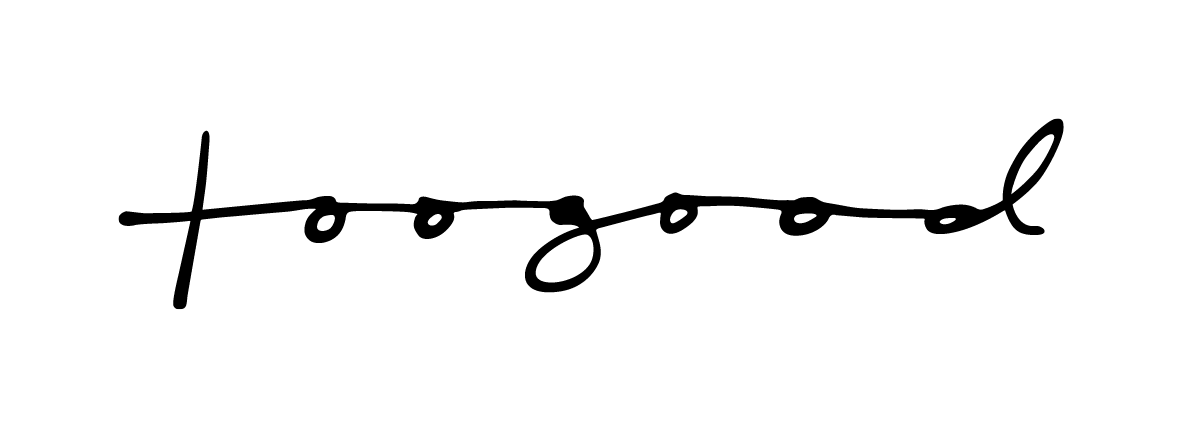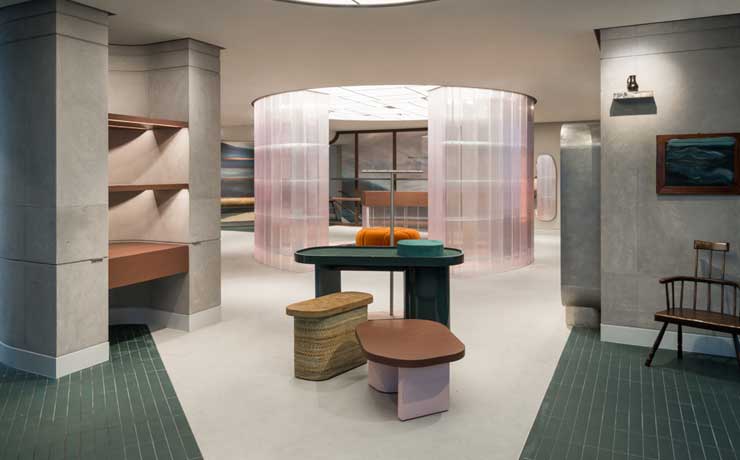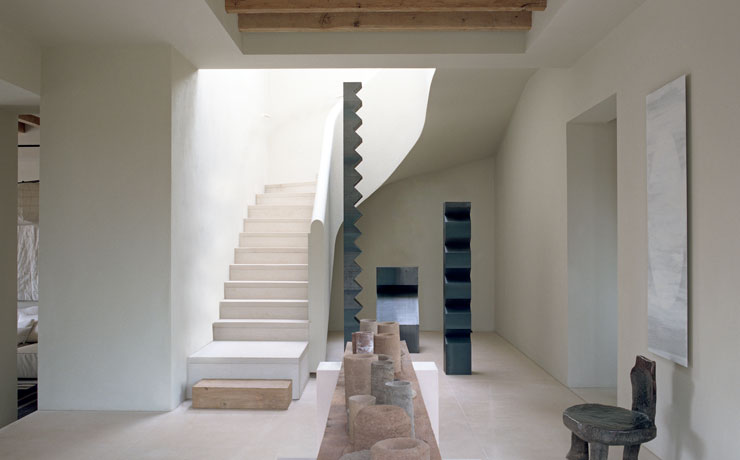2019年2月
ニューヨークタイムズ - Tマガジン
文:ナンシー・ハス
写真: ハリー・ミッチェル
デザイナーのフェイ・トゥーグッドは、単純な美しさにはまったく興味がない。流行など気にしない。むしろ、自分の作品を見て不安になり、今が何年なのか、何世紀なのかさえも突然わからなくなるような作品のほうが好きだという。博識な42歳のトゥーグッドの作品には、まるでエイリアンの化石のように、そうした混乱が埋め込まれている。トゥーグッドは過去10年間、未来的であると同時に先史時代風でもあるオブジェ、家具、衣服、住宅内装を創作してきた。園芸用の鋤の柄のような背もたれのある椅子、暗い灰色の壁と金属製の檻のような本棚がある、家具がまばらなジョージアン様式の家、ボイルドウールとアイボリーのキャンバスで作られたオーバーサイズでジェンダーレスな衣服などだ。トゥーグッドは、現代デザインのミニマリストの中でも最も詩的な存在であると広く考えられている。
さらなる証拠は、トゥーグッドと15人のスタッフが2016年から働いているロンドンのビルだ。このビルは、かつてはボヘミアンな雰囲気が漂うショーディッチ地区にある。めまいがするほど薄い、4階建て、1,800平方フィートのビクトリア朝様式のタウンハウスは、かつては荒れ果てた不法占拠住宅だったが、家主は4年間の賃貸契約で家賃を値下げした。クリエイティブな起業家の多くは、苦労して(そして高額な)ショールームにするための比較的恒久的な拠点を切望しているが、2000年代に10年近く『The World of Interiors』誌のスタイリスト兼編集者として働いたトゥーグッドは、移転の可能性を気にしていない。ここは、彼女の会社が過去8年間で入居した6つ目のスタジオスペースだ。彼女は引っ越しが好きなのだ。手作りの作品で永続性を表現するようにデザインされている人にとっては矛盾しているように思えるかもしれないが。トゥーグッドは、他人のために設計する豪華な住宅とは対照的に、従業員のために居心地のよい、活気のある職場をほぼ一夜にして作り上げるという挑戦を楽しんでいます。彼女の最後のスタジオは、かつての衣料品工場のロフトのような建物でしたが、次回はガラス張りのオフィスビルの中になるかもしれません。「私は快適なものが好きです」と彼女は言います。「でも、快適すぎるのは嫌です。」
スタジオ トゥーグッドのこの姿は、はかないものであるにもかかわらず、微妙に異世界の雰囲気を漂わせながら、長く続く抱擁のように感じられます。壁と凹凸のある木の床の両方に同じ色合いのオフホワイトのペンキを数回塗り、高い棚から葉が垂れ下がっている蔓性の鉢植えの植物が並ぶこの場所は、核の冬の後に生まれた新生文明の聖域のようです。
彼女は建物の外装の 1 階をチョークのような黒に塗り、ファサードの残りの部分は天然のレンガのままにしました。そのコントラストが、壁画やブティックが並ぶレッドチャーチ ストリートに面したアーチ型の窓を際立たせています。彼女は入り口を横に移動して (離れにある窓のない元ガレージを通って)、空間へのより広いアクセスを作りました。これにより、ファサードは少し荒れた個人住宅の雰囲気を残すことにも役立ちました。
イギリスの陶芸家オリビア・フィデスと共同制作した太めの取っ手のマグカップや丸々としたボウルを飾ったシンプルな木製のベンチが並ぶだけの地味なエントランスは、内部の明るい空間とは裏腹に。トゥーグッド自身も、暗闇から光へと、美的に同じような道を進んでいるようだ。現代画家で彫刻家のアンゼルム・キーファーの憂鬱な構成に長くインスピレーションを得てきた彼女は、泥臭いインテリアや家具で名声を博した。これは、光沢のある表面や白い壁で明るくしようとするイギリスのデザイナーたちへの反抗だった。しかし最近の彼女の作品は、より淡く、荒々しい感じが少なくなり、より丸みを帯びた有機的な形になっている。2017年、彼女はエタとレンという双子の娘を出産した(彼女と建築ライターの夫マット・ギバードには、インディゴという6歳の娘もいる)。そして彼女は、小さな子供たちの世話をすることで、より楽観的な世界観が生まれたかもしれないと認めている。 「好むと好まざるとにかかわらず、自分自身が一種の無知に戻ってしまうことに気づくのです」と彼女は言う。
高床式の石畳の小道にはシダが点在し、入り口とメインハウスを繋いでいる。中に入ると、分厚い木製の両開きドアがあり、1階の隣接する2つのパーラーが空き店舗になっており、ここがトゥーグッドが初めて営業する店舗となっている。隕石のようなセメントの塊に埋め込まれた金属の棒で作られたラックには、建物の最上階にある小さなアトリエでトゥーグッドが、パターンカッターの名人である妹のエリカと一緒に作っている服が並んでいる。生地は季節によって変わるが、加硫ゴム、手紡ぎのアルパカ、透け感のあるオーガンザなど、産業革命以前の作業着をベースにしたジェンダーレスな形は、養蜂家や彫刻家などの愛称で呼ばれ、2013年にラインがデビューして以来変わっていない。(小売店には、ニューヨーク、ロンドン、東京のドーバー ストリート マーケットがある。)片隅にはブロンズのローリーポリ ラウンジチェアがある。彼女のトレードマークである椅子は、赤ちゃんサイの下半身から彫り出されたアイスクリームスクープに似ており、アルミニウムから鋳造ガラスまでさまざまな素材で作られています。近くの低いベンチには、折り紙のように硬い4種類のジーンズが積み重ねられています。デザイナーがイングランド北部で製造した英国産デニムから縫い上げたジーンズです。
オフィスとして使われている部屋は、7×10フィートの本が並んだ書斎で、アパレル商品を眺めている間も見える。数フィート離れたキッチンでは、デザインクライアントや時折買い物にやってくる客がお茶に招かれ、そこではデンマークのホルムバック・ノルデントフトがデザインした流線型の電気ケトルが、トゥーグッドがリサイクルショップで見つけた白黒の市松模様の石のシンクのそばで沸かされている。石のカウンターの隅に設置され、ぴったり合うようにカットされているが、壁に完全に固定されていない。浮いているような効果は見た目にも美しく、実用的でもある。リースが切れたら、取り外して次のスタジオ・トゥーグッド行きのトラックに積み込むことができる。
上の作業室へ続く階段を上るのは危険だ。きしむ木製の踏み板は危険なほど狭く、建物は上るにつれて狭くなり、天井も低くなる。一階上がると、寝室ほどのスペースで数人のデザイナーがコンピューターで作業しており、次の階にはドールハウスほどの大きさの家具の模型が所狭しと並べられた部屋があり、天井まで届く棚にはトゥーグッドが好む素材の小さなサンプルが並べられている。荒い石、滑らかな石膏、金属格子などだ。最後のぐらぐらする階段を上ったところ、実質的に床面積のすべてを占める食堂のテーブルの上には、エリカと彼女の小さなスタッフが、次のシーズンの衣料品コレクション用にワックス加工した綿と防水シートの厚いロールを裁断している。
トゥーグッドのスタジオは親密な雰囲気を漂わせているが、精神的にはすでにこの温かみのある白い子宮を越えたとトゥーグッドは打ち明ける。彼女の次の家具やオブジェのコレクションには、赤みがかった紫や、彼女がカラミンと呼ぶ「ピンクピンク」など、初めて色が取り入れられる。「人は変わるものよ」と彼女は言う。「その美しさは、自分が決して行けるとは思ってもいなかった場所に行くことなの」
記事全文は、 こちらから現地でご覧ください。


